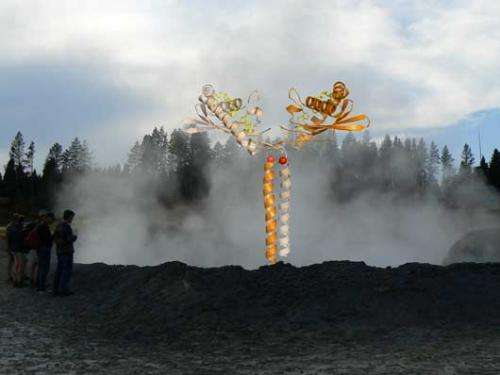The basic building blocks of life to be rethought after one discovered to be missing

(Phys.org) -- A gene thought previously to be present in all life on earth has been found to be missing in life near volcanoes.
The protein, thought to be one of the fundamental building-blocks of life, is not present in certain volcanic single cell organisms.
The scientists studied archaea, which are similar to bacteria, but have an independent evolutionary history, for the research. The research published in the Proceedings of the National Academy of Sciences (PNAS) found the expected gene missing and another in its place.
This missing protein, named SSB, performs an essential role binding DNA and protecting it from damage. Professor Malcolm White of the School of Biology at the University of St Andrews said: “All cells, whether they are microbial or human, have some things in common.
“These are the fundamental components or building blocks which were present in the first cells and have been passed on over 3.5 billion years.
“However, we have discovered that a gene normally thought to be absolutely essential and conserved throughout every form of life, is in fact lost in one group of volcanic bugs, and replaced by a completely novel gene we have christened ThermoDBP.”
The discovery has ramifications for understanding about how life has evolved on earth.
The new gene could have applications in biotechnology and the new scientific discipline of synthetic biology.
More information: Displacement of the canonical single-stranded DNA-binding protein in the Thermoproteales, PNAS, Published online before print November 21, 2011, doi: 10.1073/pnas.1113277108
Abstract
ssDNA-binding proteins (SSBs) based on the oligonucleotide-binding fold are considered ubiquitous in nature and play a central role in many DNA transactions including replication, recombination, and repair. We demonstrate that the Thermoproteales, a clade of hyperthermophilic Crenarchaea, lack a canonical SSB. Instead, they encode a distinct ssDNA-binding protein that we term “ThermoDBP,” exemplified by the protein Ttx1576 from Thermoproteus tenax. ThermoDBP binds specifically to ssDNA with low sequence specificity. The crystal structure of Ttx1576 reveals a unique fold and a mechanism for ssDNA binding, consisting of an extended cleft lined with hydrophobic phenylalanine residues and flanked by basic amino acids. Two ssDNA-binding domains are linked by a coiled-coil leucine zipper. ThermoDBP appears to have displaced the canonical SSB during the diversification of the Thermoproteales, a highly unusual example of the loss of a “ubiquitous” protein during evolution.
Journal information: Proceedings of the National Academy of Sciences
Provided by University of St Andrews


















